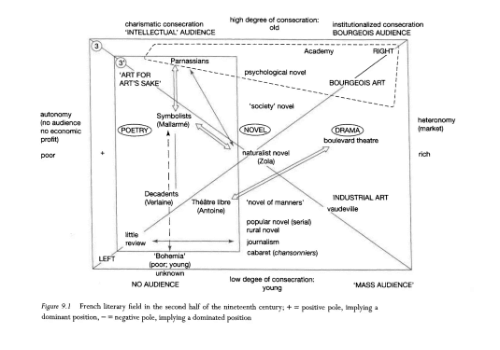Pierre Bourdieu's Field of Cultural Production

Pierre Bourdeiu's concept of the field of cultural production is a very powerful model for describing the cultural status or value of a book or other cultural product at a certain time and place.
As visualized in the linked image above, Bourdieu's system categorizes cultural products into
- rich vs. poor, (left/right axis) and
- old vs. young (top/bottom axis).
RICH AND POOR
"Rich" products (books, visual art, movies, etc.) are market-oriented and money-making while "poor" ones (different books, art, movies) not highly marketable, but can be valuable because they're independent of the market and therefore authentic. In this sense, rich and poor represent two kinds of cultural value or authority. In Bourdieu's diagram, drama is rich, poetry is poor, and the novel is in between.
OLD AND YOUNG
"Old" products are established--Bourdieu uses the interesting word "consecrated," suggesting how classic, canonical works can have an almost sacred status in a society--while "young" products can achieve status instead by being cutting edge and of the moment.
PLACE AND TIME
Where Bourdieu's ideas get interesting is suggested by his caption at the bottom of the diagram, where he makes the point that what's rich/poor/old/young changes depending on the place and moment in history. The specifics he populates his diagram with, for instance, come from 19th-century France. As time move forward, particular works or authors (producers) can move around in the field, from young toward old, from poor to rich (or the other way). Bourdieu shows this in the diagram with arrows.
POSITION IN THE FIELD
What's REALLY interesting about Bourdieuan is only suggested from the diagram itself: these four values are comparative and dynamic.The significance of any particular piece of culture comes from its relative position in the field.
For instance, the value of the old or "consecrated" is drawn from its position in the field in relation to the young (and vice versa). In other words, the classics we have now are classics partly in how they oppose the "young" cultural products and the new cultural values they represent. And what's culturally compelling about "young" products is often how they rebuke or react against the old.
Same with rich and poor: the poor texts are interesting for the very reason that they do things that the rich products can't because the market doesn't support it, and so the poor products become a way to oppose or criticize the market and everything it represents or entails at that moment and place in history.
The meaning of a text, then, does not simply emanate from the content and form of the text, or even from its relationship to its audience, but also from the text's location in the field in relation to lots of other cultural productions--a location that changes with time and events, thus changing its cultural meaning.